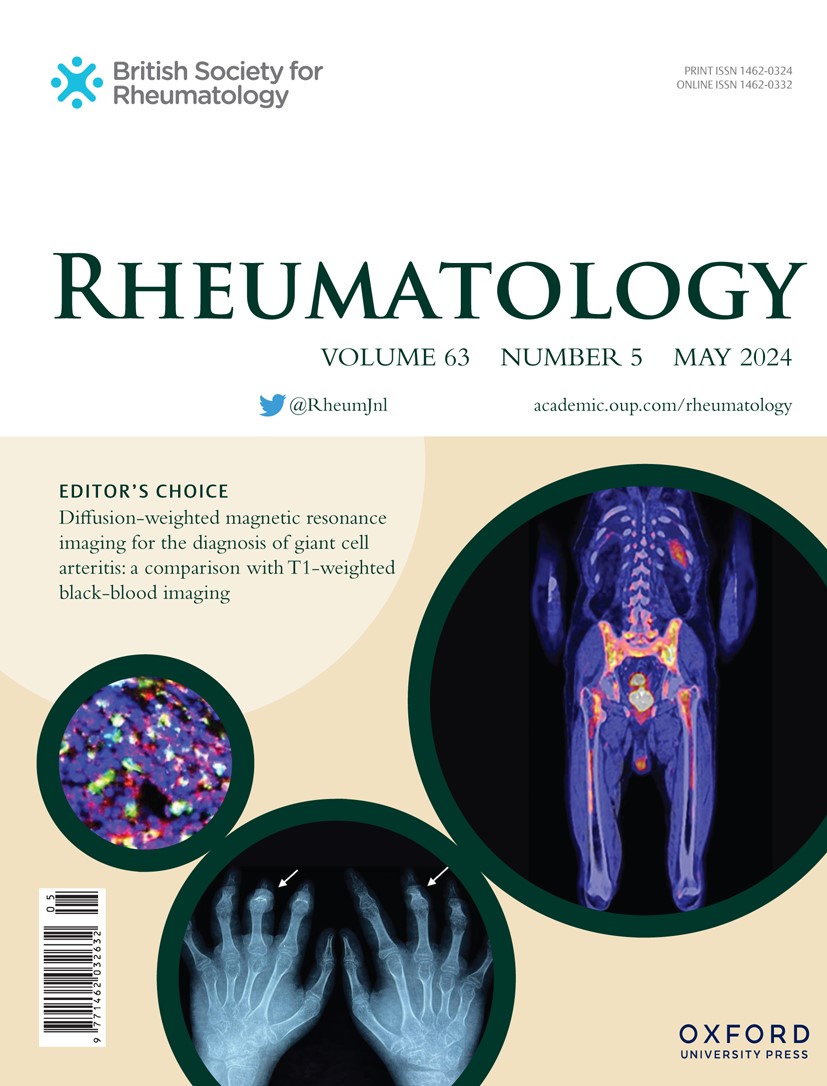免疫吸附作为一种治疗难治性特发性炎性肌病的新方法——一项回顾性观察研究
IF 4.7
2区 医学
Q1 RHEUMATOLOGY
引用次数: 0
摘要
目的特发性炎性肌病(IIM)是一种以肌肉炎症、高肌酸激酶(CK)水平和残疾为特征的自身免疫性疾病。尽管有免疫调节治疗,但患者经常经历进行性疾病,导致难治性疾病或对糖皮质激素(GC)的依赖。本研究探讨免疫吸附(IAS)治疗难治性IIM的有效性和安全性。方法对2000年1月至2021年9月期间接受IAS治疗的高活动性IIM患者进行回顾性、单中心研究。纳入标准是确诊IIM对标准治疗无反应的成年患者,包括GC和至少一种改善疾病的抗风湿药物。主要终点被定义为轻微改善,在第12周需要每日gc剂量和ck水平降低≥20%,同时患者比较自我评估(PCSA)被评为“无变化”或“更好”。次要终点包括在第4、8和12周时的中度(≥40%)和主要(≥60%)改善。在最后一次IAS程序后的3个月内评估复发率。结果本研究纳入了23例经IAS治疗的难治性IIM患者。达到主要终点的患者占52.2% (n = 12)。在第4、8和12周,分别有8.7% (n = 2)、26.1% (n = 6)和34.8% (n = 8)患者出现中度改善,8.7% (n = 2)、17.4% (n = 4)和30.4% (n = 7)患者出现显著改善。未报告意外不良事件,ias后3个月内复发率低(18%)。结论IAS可能是对GC难治性患者和常规治疗的有效辅助治疗,可快速降低CK水平,减少GC的使用,改善PCSA和肌肉功能。本文章由计算机程序翻译,如有差异,请以英文原文为准。
Immunoadsorption as a novel therapy for refractory idiopathic inflammatory myopathies—a retrospective observational study
Objective Idiopathic inflammatory myopathies (IIM) are autoimmune disorders characterised by muscle inflammation, high creatine kinase (CK) levels, and disability. Despite immunomodulating therapies, patients often experience progressive disease, resulting in refractory conditions or dependence on glucocorticoids (GC). This study addresses the efficacy and safety of immunoadsorption (IAS) in refractory IIM. Methods A retrospective, monocentric study was conducted on patients with highly active IIM subjected to IAS between January 2000 and September 2021. Inclusion criteria were adult patients with confirmed IIM unresponsive to standard therapies, including GC and at least one disease-modifying antirheumatic drug. Primary end point was defined as minor improvement, requiring a ≥ 20% reduction in both daily GC-dosage and CK-levels at week 12, alongside patient comparative self-assessment (PCSA) rated as “no change” or “better.” Secondary endpoints included moderate (≥ 40%) and major (≥ 60%) improvements at weeks 4, 8, and 12. Relapse rates were assessed over a 3-month period following the last IAS procedure. Results The study included 23 refractory IIM patients treated with IAS. Primary end point was reached by 52.2% (n = 12) patients. Moderate improvement was observed in 8.7% (n = 2), 26.1% (n = 6), and 34.8% (n = 8) and major improvement in 8.7% (n = 2), 17.4% (n = 4), and 30.4% (n = 7) at weeks 4, 8, and 12, respectively. No unexpected adverse events were reported, with low relapse rates within 3 months post-IAS (18%). Conclusion IAS may be an effective adjunctive therapy in patients refractory to GC and conventional treatments, leading to rapid CK level reductions, decreased GC usage, and improvements in PCSA and muscle function.
求助全文
通过发布文献求助,成功后即可免费获取论文全文。
去求助
来源期刊

Rheumatology
医学-风湿病学
CiteScore
9.40
自引率
7.30%
发文量
1091
审稿时长
2 months
期刊介绍:
Rheumatology strives to support research and discovery by publishing the highest quality original scientific papers with a focus on basic, clinical and translational research. The journal’s subject areas cover a wide range of paediatric and adult rheumatological conditions from an international perspective. It is an official journal of the British Society for Rheumatology, published by Oxford University Press.
Rheumatology publishes original articles, reviews, editorials, guidelines, concise reports, meta-analyses, original case reports, clinical vignettes, letters and matters arising from published material. The journal takes pride in serving the global rheumatology community, with a focus on high societal impact in the form of podcasts, videos and extended social media presence, and utilizing metrics such as Altmetric. Keep up to date by following the journal on Twitter @RheumJnl.
 求助内容:
求助内容: 应助结果提醒方式:
应助结果提醒方式:


